Best winter plants for pots: 17 bright ideas for cold-weather containers
These winter plants for pots will inject plenty of seasonal interest into your garden

Holly Crossley
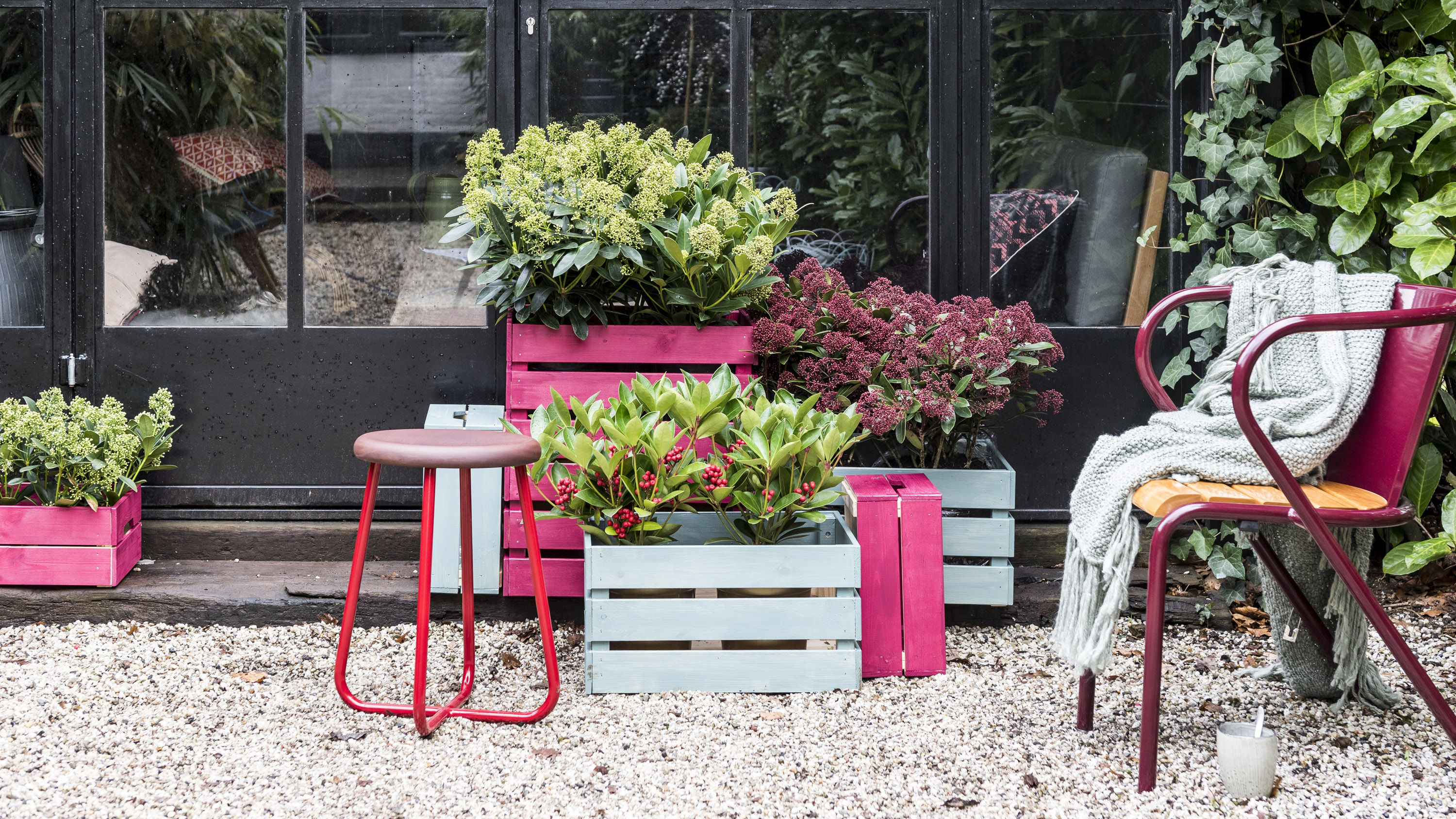
Bright summer blooms inevitably fade as the seasons shift. But, the best winter plants for pots will keep the spirits lifted and the garden looking beautiful, despite colder temperatures and darker evenings.
There are plenty of stunning winter garden ideas that will bring a smile to your face on frosty days. But one of the best ways to brighten up an outdoor space is to plant some gorgeous containers. With flower beds and borders looking a little bare over the coldest season, using pots is a great way to ensure there is still plenty of interest in your yard during the months ahead. Of course, many winter-flowering plants will provide vital nectar for foraging wildlife, too – even more reason for introducing them to your plot.
'Remember that plants in containers will take less cold than the same varieties planted in the ground,' says Graham Rice, a gardening expert from Amateur Gardening. 'So, for containers, plan as if your garden is one zone colder than it actually is and choose only the most frost-hardy varieties.'
To give you lots of inspiration, we've rounded up our favorite winter plants you can use in your containers for a stunning display.
Wonderful winter plants for pots to try in your yard
Want to ensure your container gardening ideas are packed with color, scent and interest throughout the colder weather? Our edit of winter plants for pots is the perfect place to start.
1. Wintergreen
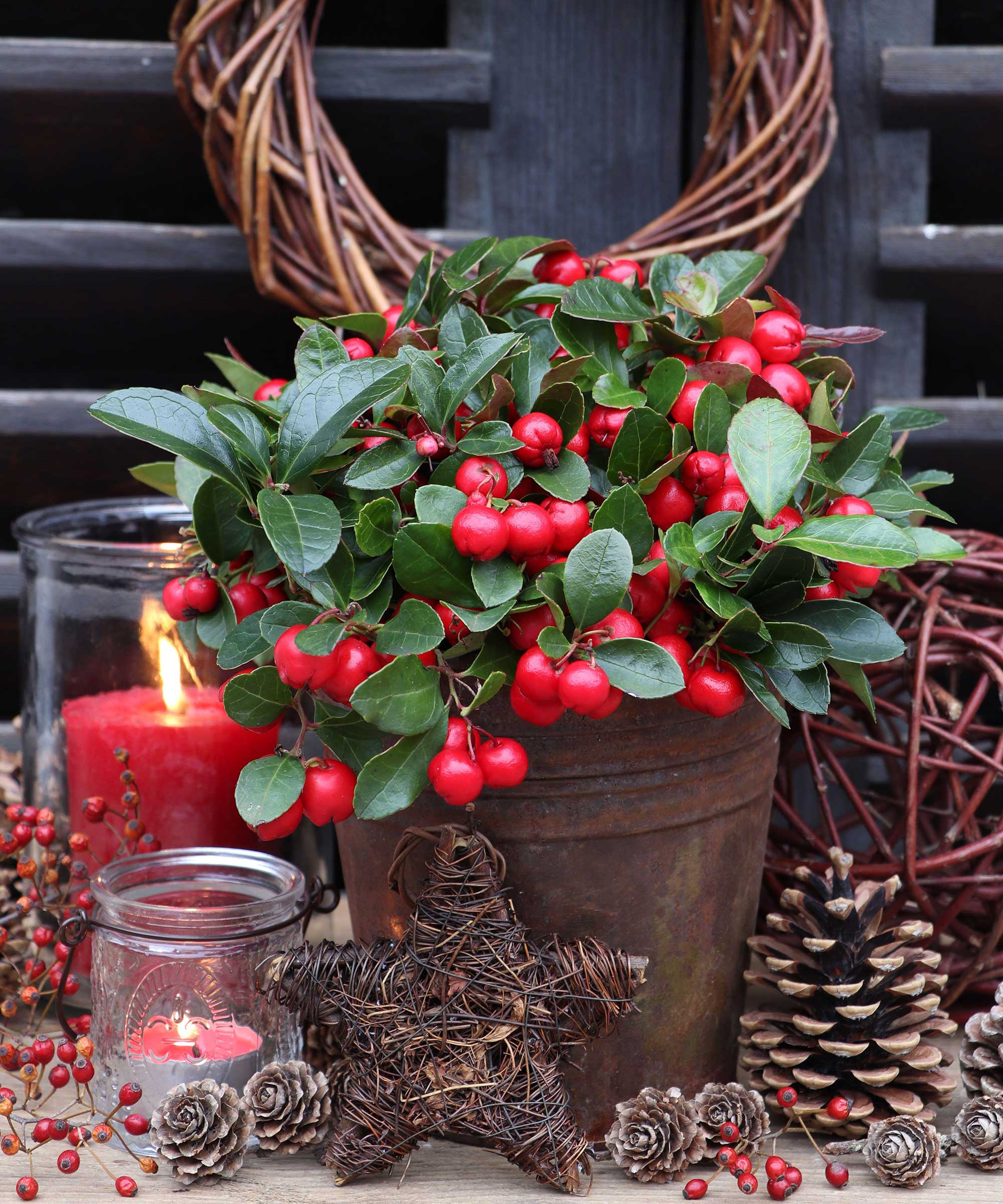
Wintergreen (or Gaultheria procumbens) planted in pots makes a cheery addition to outdoor Christmas decor with its vibrant red berries. Alternatively, try Gaultheria 'Pearls' which has white berries with a pink flush. Both will thrive in full to part shade.
Replant these dwarf evergreens in a larger container or into your borders as a ground-cover plant when it's time to give your winter pots a refresh. Be sure to always wear gloves when handling these plants, however, as they are toxic.
2. Primulas
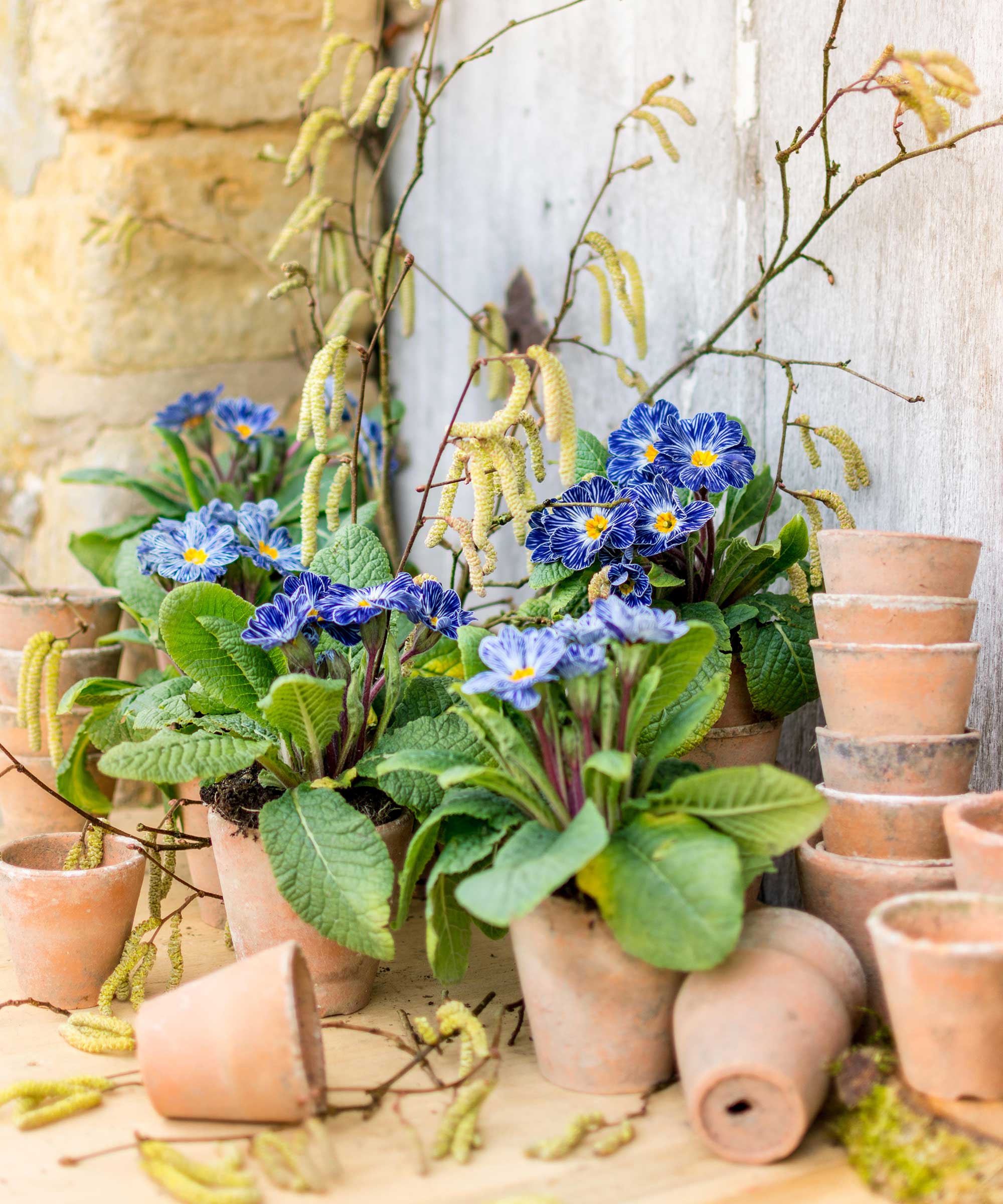
Primulas are a classic winter bedding plant, bringing a big boost of bold color to a display. Some are hardier than others, one of our favorites being 'Zebra Blue' which has striped flowers and yellow centers. It blooms in late winter through to late spring and thrives in partial shade. Take a cue from this setup and push structural twigs into the soil for extra height and drama.
As perennials, keep these beauties going once the season ends by planting them into your borders. As they grow, they will form large clumps which can be divided to improve vigor (and to get 'new' free plants).
Summer or autumn is the best time to do so: 'Simply lift a plant and, using two hand forks inserted close together and back-to-back, divide the clump into chunky, well-rooted portions,' says John Negus, a gardening expert from Amateur Gardening. 'Replant them in a shady spot for summer and, in autumn, set them where they are to flower in spring.'
Polyanthus – a type of primula which produces flowers in umbels – is also one of our favorite winter plants for pots. Sue Sanderson, writing for Thompson & Morgan, recommends ‘Firecracker’ for a fragrant display. Deadhead the flowers often to encourage prolific blooming.
3. Winter irises
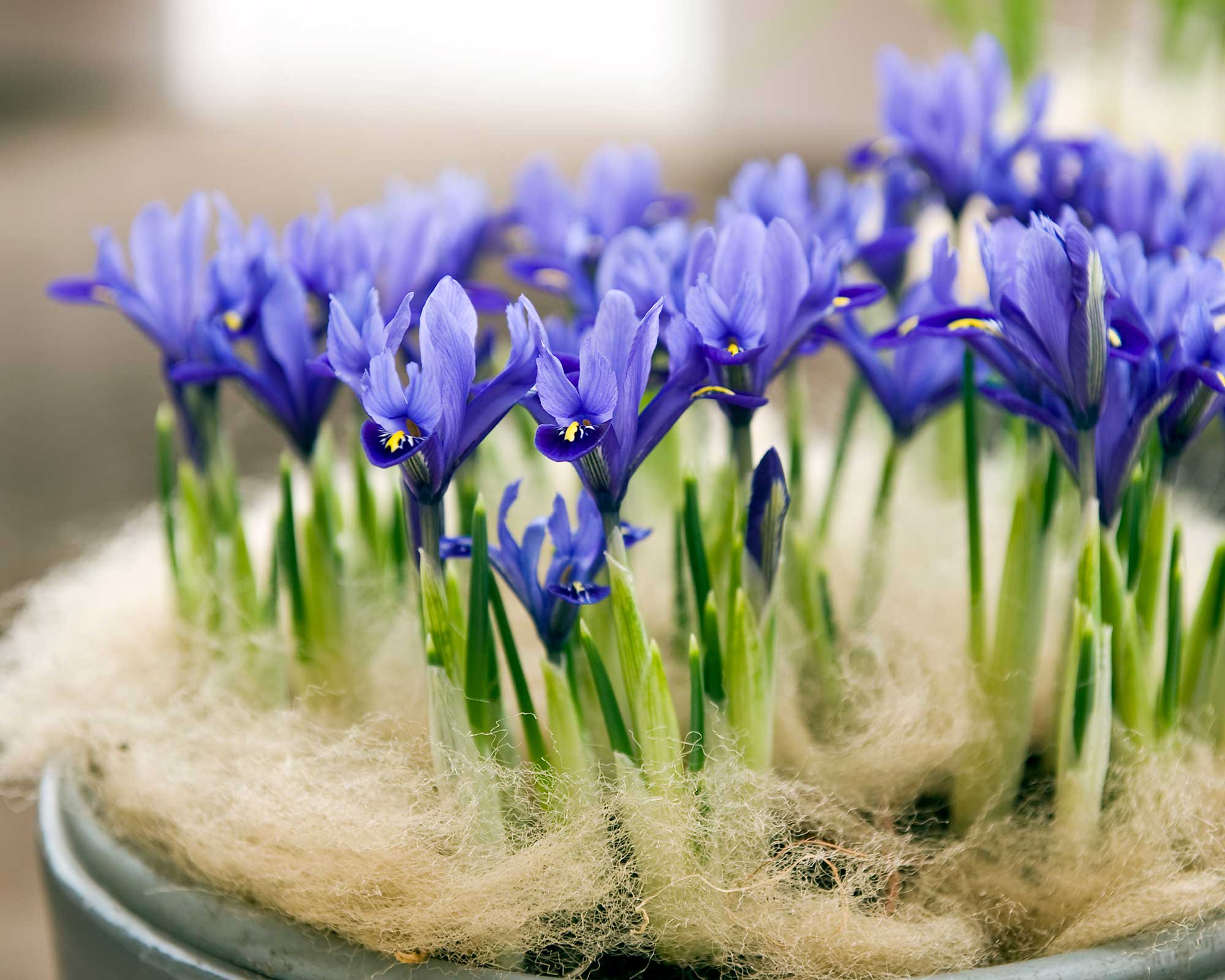
With their elegant structure and jewel-like tones, winter irises will brighten any patio or doorstep. The team at Amateur Gardening suggests 'Harmony' – a stunning bloom with rich purple-blue flowers and a golden band on the fall, which flowers in mid-winter.
For something a little different, opt for the ice-white 'Frozen Planet' when planting your winter container, which has pale-blue-tipped petals and will bloom all the way from early winter to spring. 'Pauline' is another beautiful choice, offering a sophisticated shade of plum.
Plant the bulbs in fall in well-drained soil, and for best results, position the containers in full sun. Each plant will grow to around 6in (15cm), depending on the variety.
4. Winter aconites
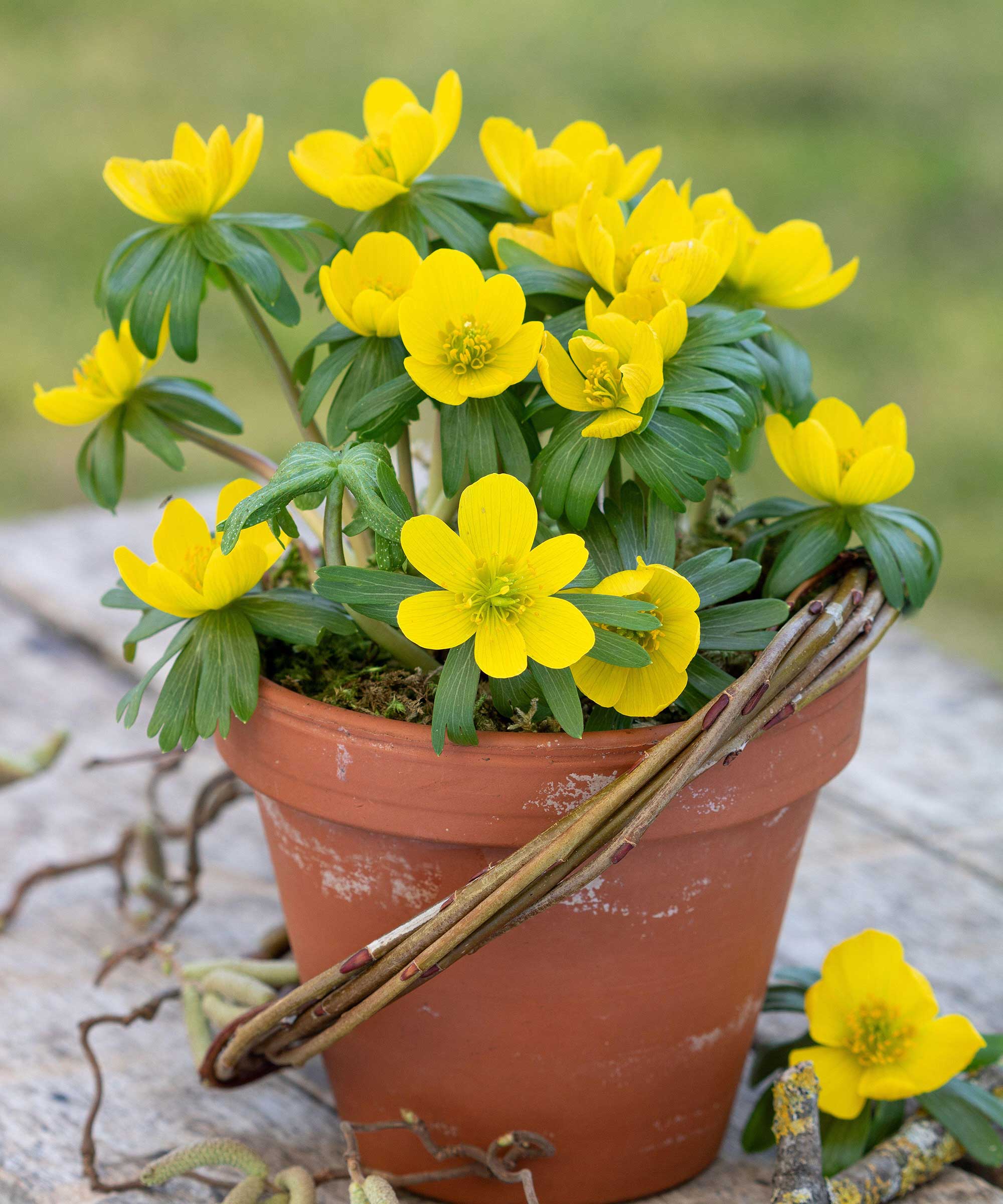
A wonderful winter garden plant, the sun-yellow flowers of aconites bring reliable cheer. 'After flowering, plant them out in humus-rich moisture-retentive soil in semi-shade, where they will naturalize,' suggests the Amateur Gardening team.
They don't grow too tall – only around 4in (10cm). Try planting up a cluster of smaller pots for an instant uplift, or dot the bulbs around the perimeter of a larger container.
Pollinators adore these buttercup-like blooms, so they're perfect if you're looking for winter wildlife garden ideas.
5. Early crocuses
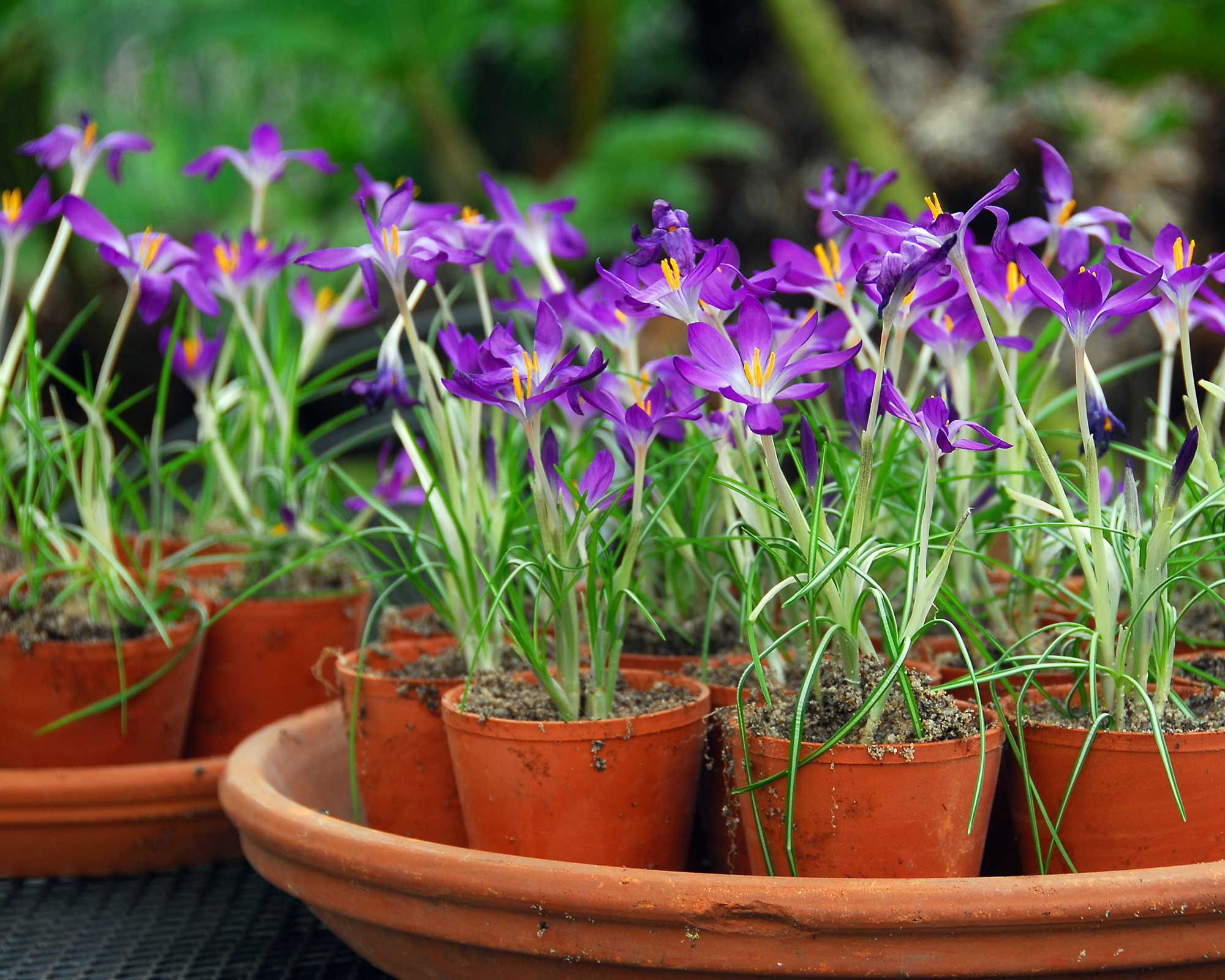
In shades of yellow, lilac, deep purple and frosty white, early crocuses are perfect for adding to winter planters.
Try 'Pickwick', a larger variety with white goblet flowers and purple veining, which will bloom in late winter in milder regions. RHS-award-winning 'Blue Pearl' is another favorite with its silvery-lilac petals and deep yellow throats, or try 'Snow Bunting' for white, star-shaped blooms with sunshine-yellow centers. If you love a deeper purple hue, then opt for 'Whitewell Purple', as shown above.
Plant crocus bulbs in well-drained containers positioned in the sun (they won't flower in shade). After flowering, plant them out in a sunny patch of a border or lawn, where they will form clumps over time.
6. Heucheras
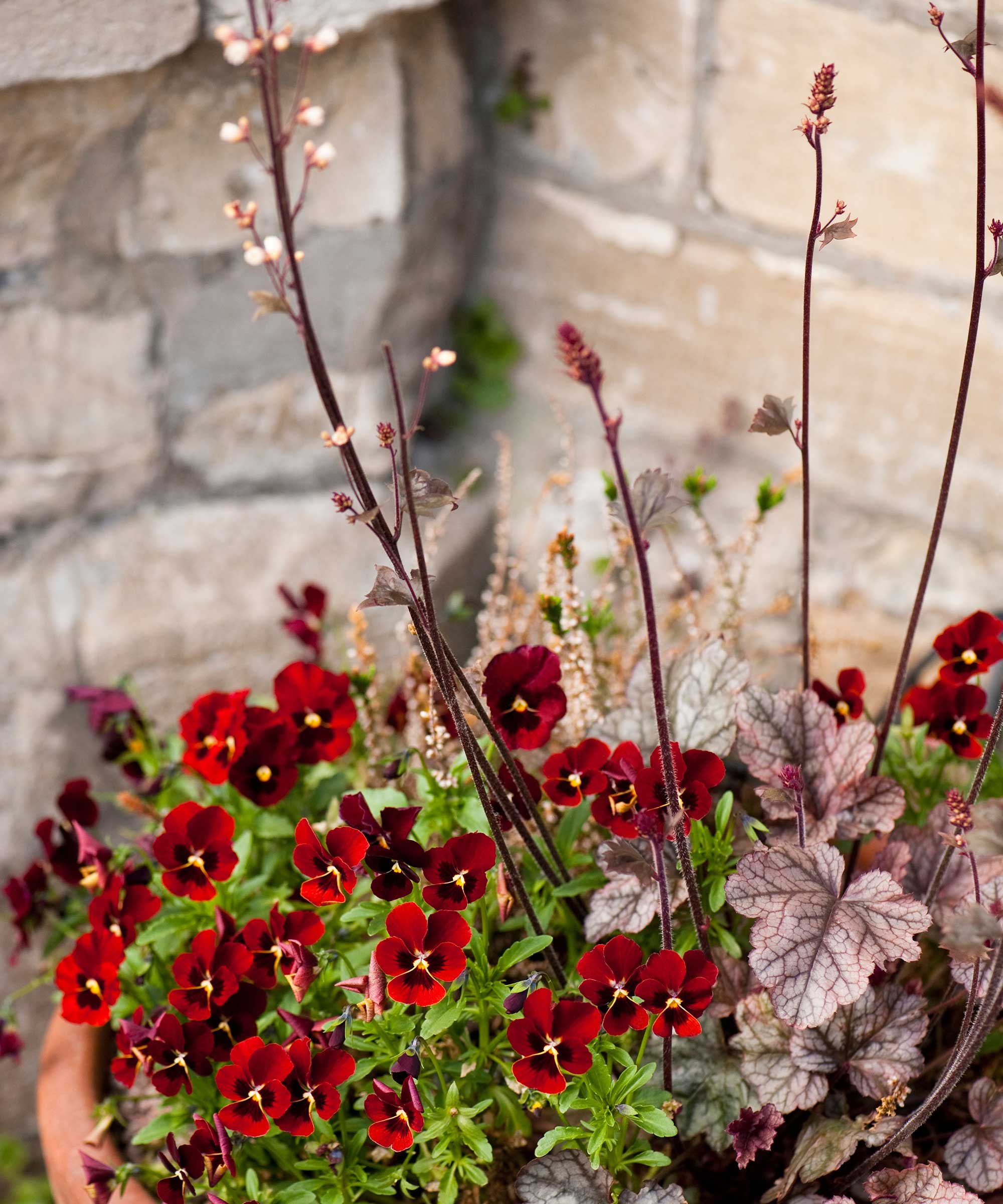
Coral bells, otherwise known as heucheras, have pretty flower spikes in summer. However, the frilly, semi-evergreen, vibrant foliage makes them a good plant for winter color, too, especially in regions where temperatures don't drop too low.
Amateur Gardening suggests 'Marmalade' as a variety to try, with its caramel and pink leaves to warm the winter scene. To set a moody, dramatic tone, opt for 'Black Pearl', whilst 'Sugar Frosting' as shown above looks gorgeously festive against ruby-red viola 'Rose Blotch'.
Plant them in moist, well-drained pots in sun or semi-shade.
7. Pansies and violas
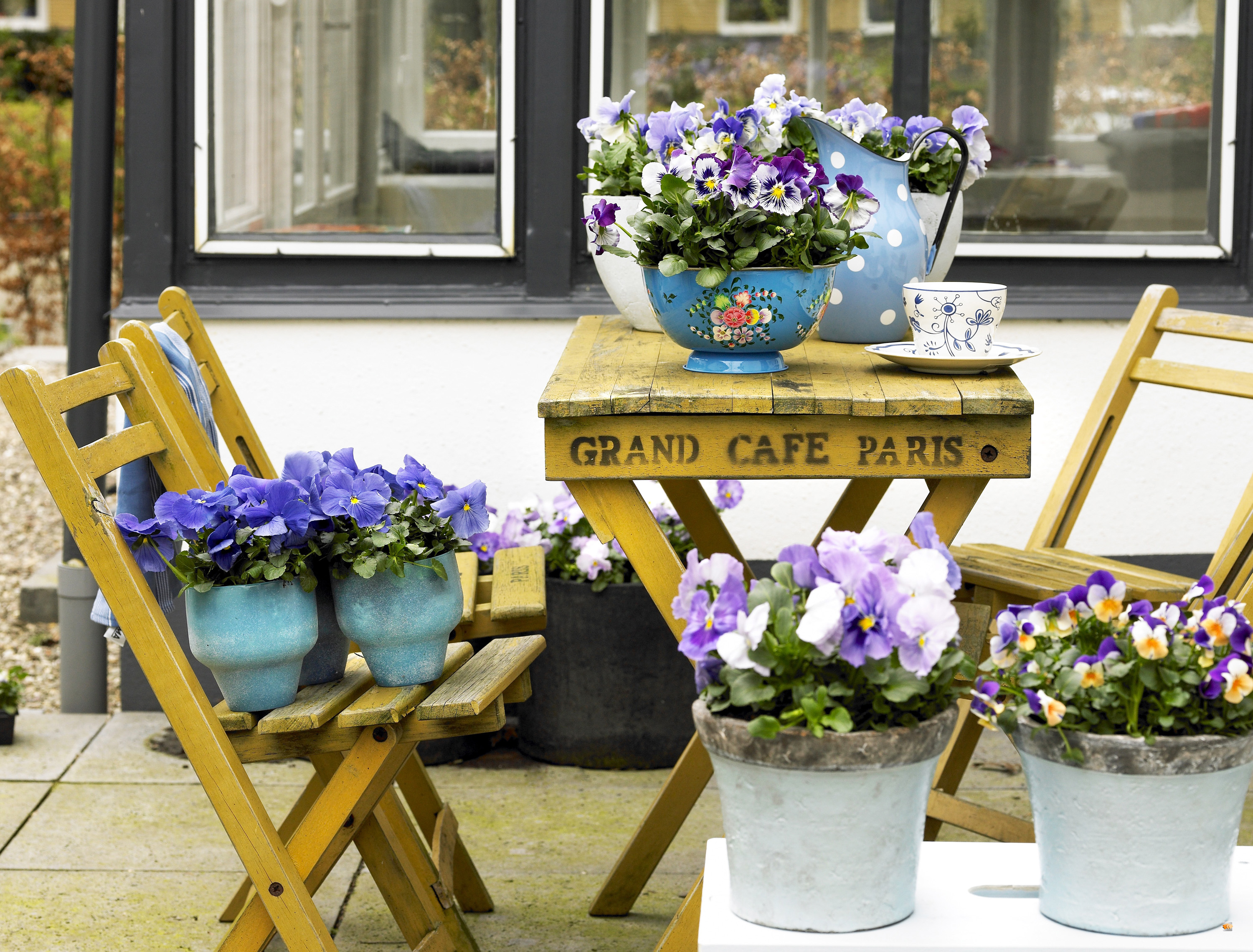
Create a container of pansies and you are guaranteed a cheering display all through autumn, winter and into early spring. These bedding plants are one of the best plants for beginners if you follow a few simple rules. Choose plants labeled as 'winter-flowering' to guarantee they will thrive in colder weather.
Plant them out at the start of autumn so they form buds before the frosts arrive. Plant in multi-purpose compost with a handful of grit to aid drainage. In dry spells, make sure the compost is moist to touch – plants can still dry out and die in the colder months.
Pack the container with plants for a full display. Deadheading flowers regularly will encourage repeat blooming. For extra impact, opt for one color, rather than a mix of shades – try 'Swiss Giant Orange' for a blaze of gold, or 'Coolwave Raspberry' for a cushion of velvety plum.
8. Heather
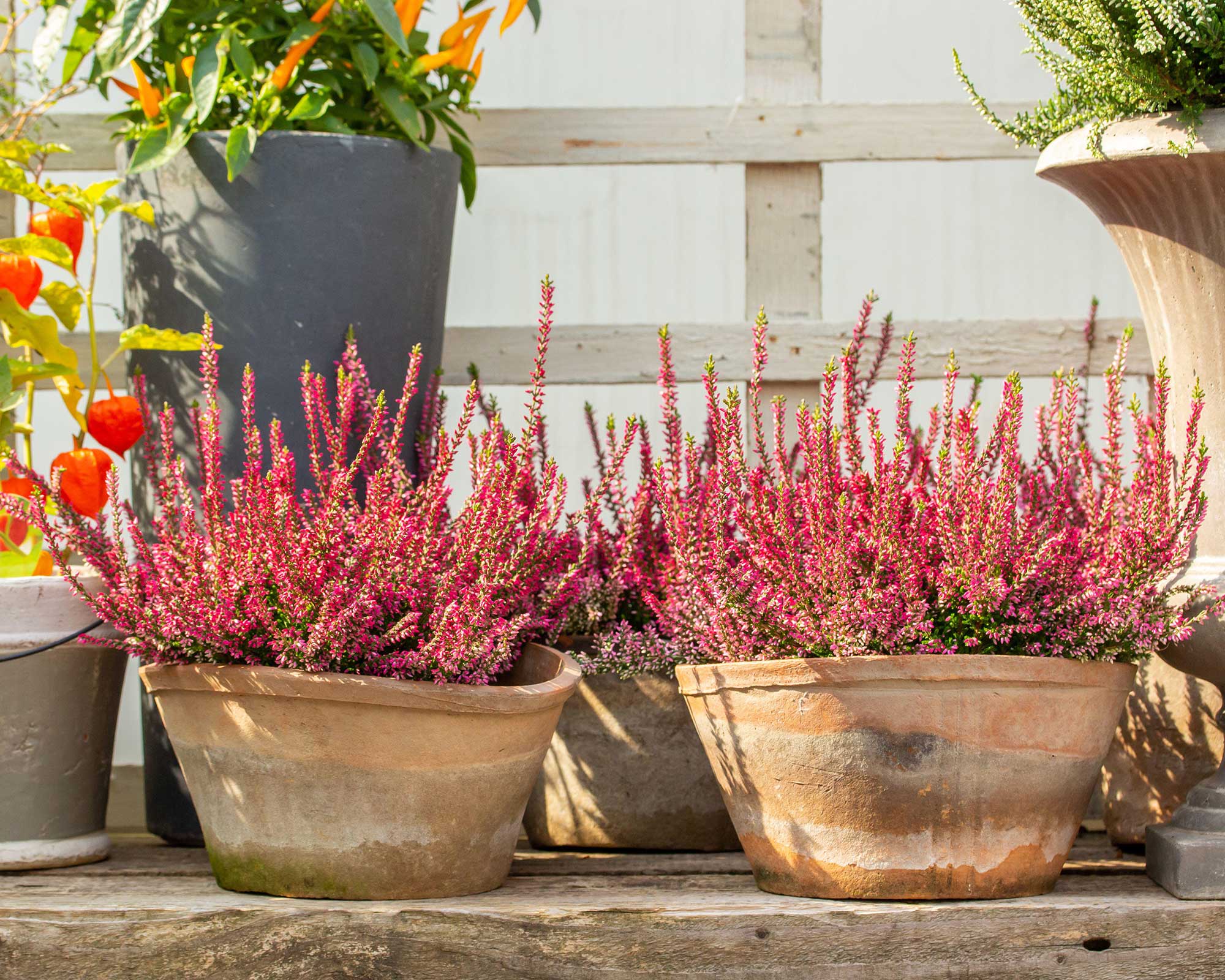
Whether it is a shade of white or dark pink, winter heather brings delicate beauty to your displays.
Heathers only thrive in acid soil, so buy a bag of ericaceous compost. Add a 1-2in (2.5-5cm) layer of grit at the base of the container first, as they do not like to have soggy roots. Grow them in a sunny spot, or partial shade.
Good choices are E. carnea 'Springwood White', which has trailing stems, and E. carnea 'Springwood Pink' for a bright pop of color.
9. Hellebores
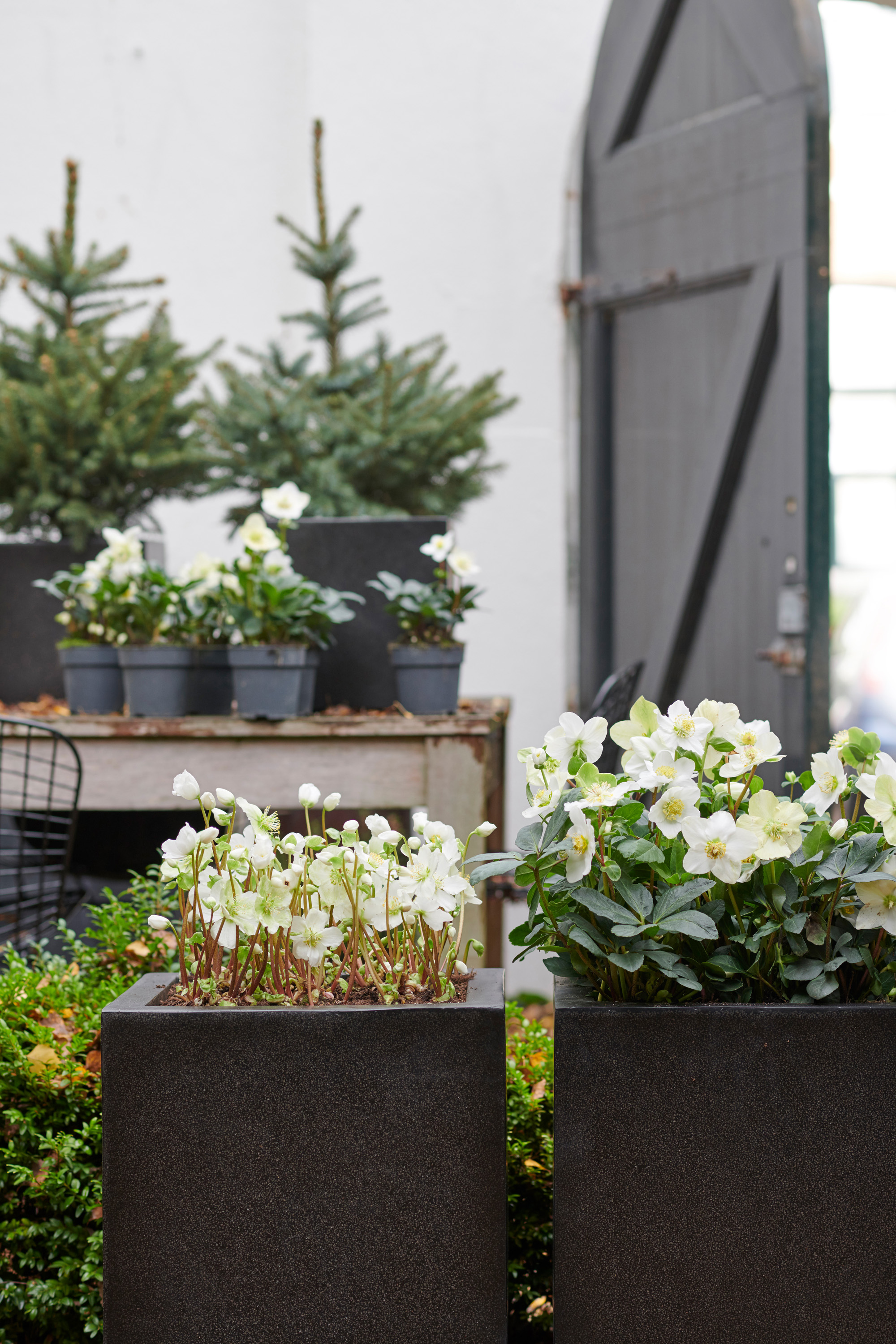
The Christmas rose, or hellebore, adds a touch of romanticism in the bleaker months. They come in a subtle rainbow of colors, from pure white and dusty pink to apricot and rich purple and they can cope with cold conditions, including frost and snow.
Hellebores are mainly evergreen, flowering in mid-winter and continuing to early spring. They can be combined with other plants in the same pot, but a simple container of one color will create maximum impact.
Plant them in a multi-purpose compost in a container, deep enough to fit with the top of the existing compost level. Water well and place in a shady spot.
10. Scented plants
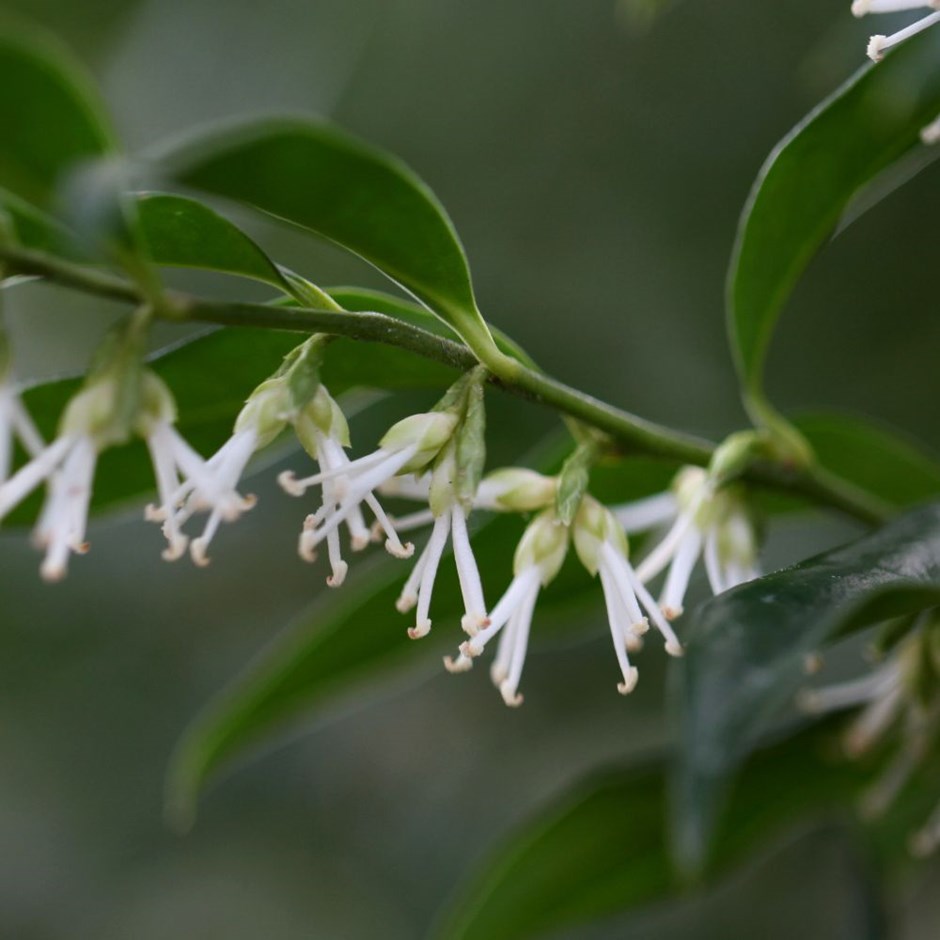
Although we associate scented plants with warm summer days, there are some cold-weather heroes which are perfect for placing by the porch for a blast of winter fragrance.
Sweet box, or Sarcococca confusa, is a brilliant option for the best winter plants for pots. It has a profusion of tiny, spidery, white flowers on glossy evergreen leaves in the winter, which turn into black berries over summer. It's an easy-care plant, with no pruning needed. Just remove any dead sprigs in late spring. For best results, plant in John Innes No.3 compost, and make sure that the soil is kept moist.
For a beautiful citrus scent in a pot, try winter-flowering honeysuckle (Lonicera fragrantissima) which has creamy-colored flowers on semi-bare branches. Plant in a large container for the best results.
- Buy Sarcococca confusa in the US: view at Nature Hills
- Buy Sarcococca confusa in the UK: view at Crocus
11. Japanese skimmia
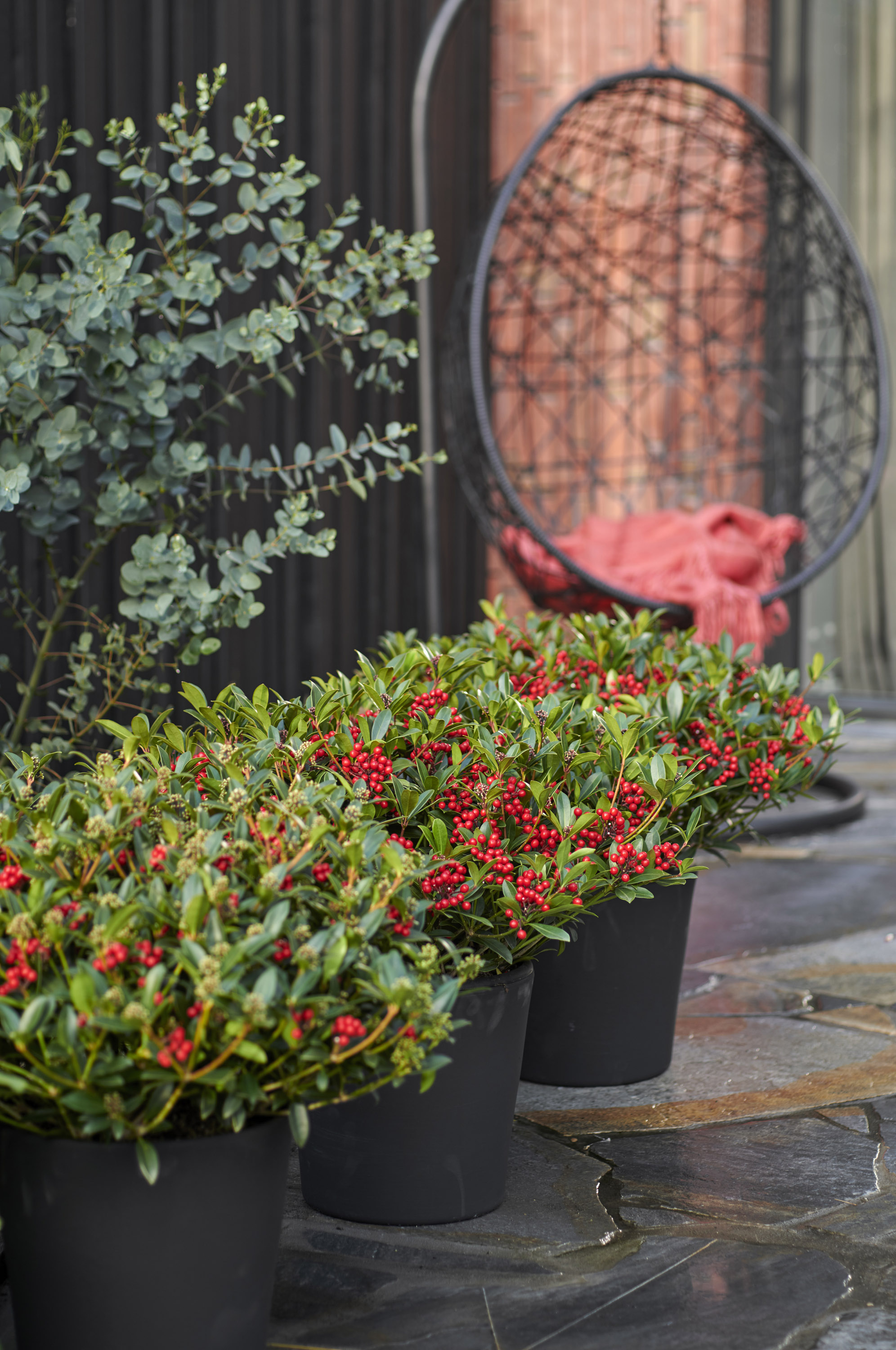
Japanese skimmia has domes of neat evergreen foliage, and the female plants – such as 'Kew Green' or 'Rubella' – are one of the best plants with winter berries. Just ensure you pair them with a male variety, otherwise, you might not get any berries at all.
The shrubs prefer partial shade, and they will cheer up a dark spot.
12. Camellia
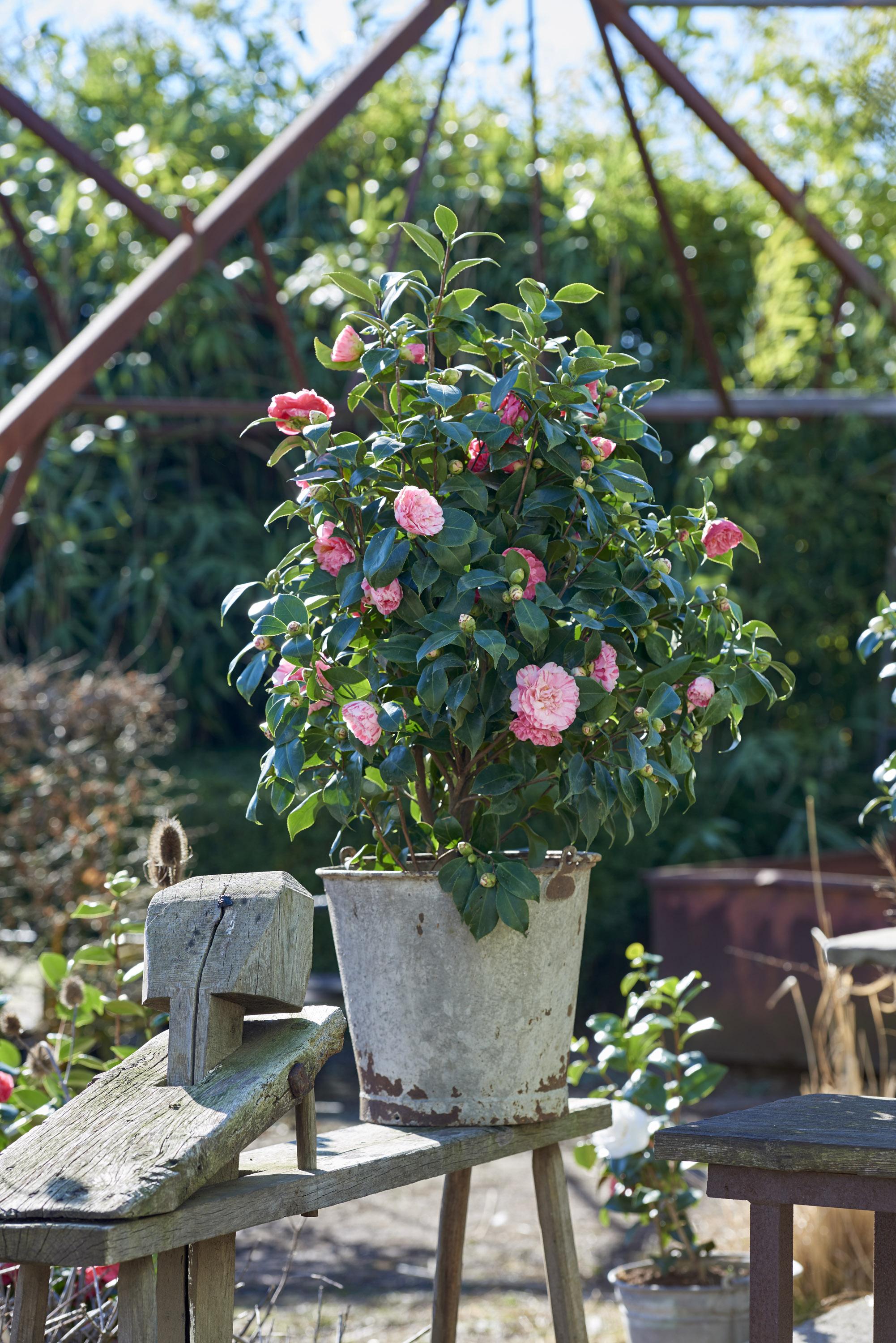
It's worth learning how to grow camellias for the spectacle of showy flowers. Camellias come in shades of pink, red and white, and their blooms contrast with their evergreen foliage.
They're ideal for growing in pots to add some interest to your winter patio. But, they do need to be planted in well-drained ericaceous (acid) soil, and if possible, they should be watered with rainwater from a water butt.
Put them in a sheltered spot near the house, and protect early buds from frost with horticultural fleece. Prune after they have flowered, and keep them well-watered through spring and summer, as this is when the buds are forming. It's definitely worth the effort, as they will reward you with a stunning display in late winter and early spring.
13. Cyclamen
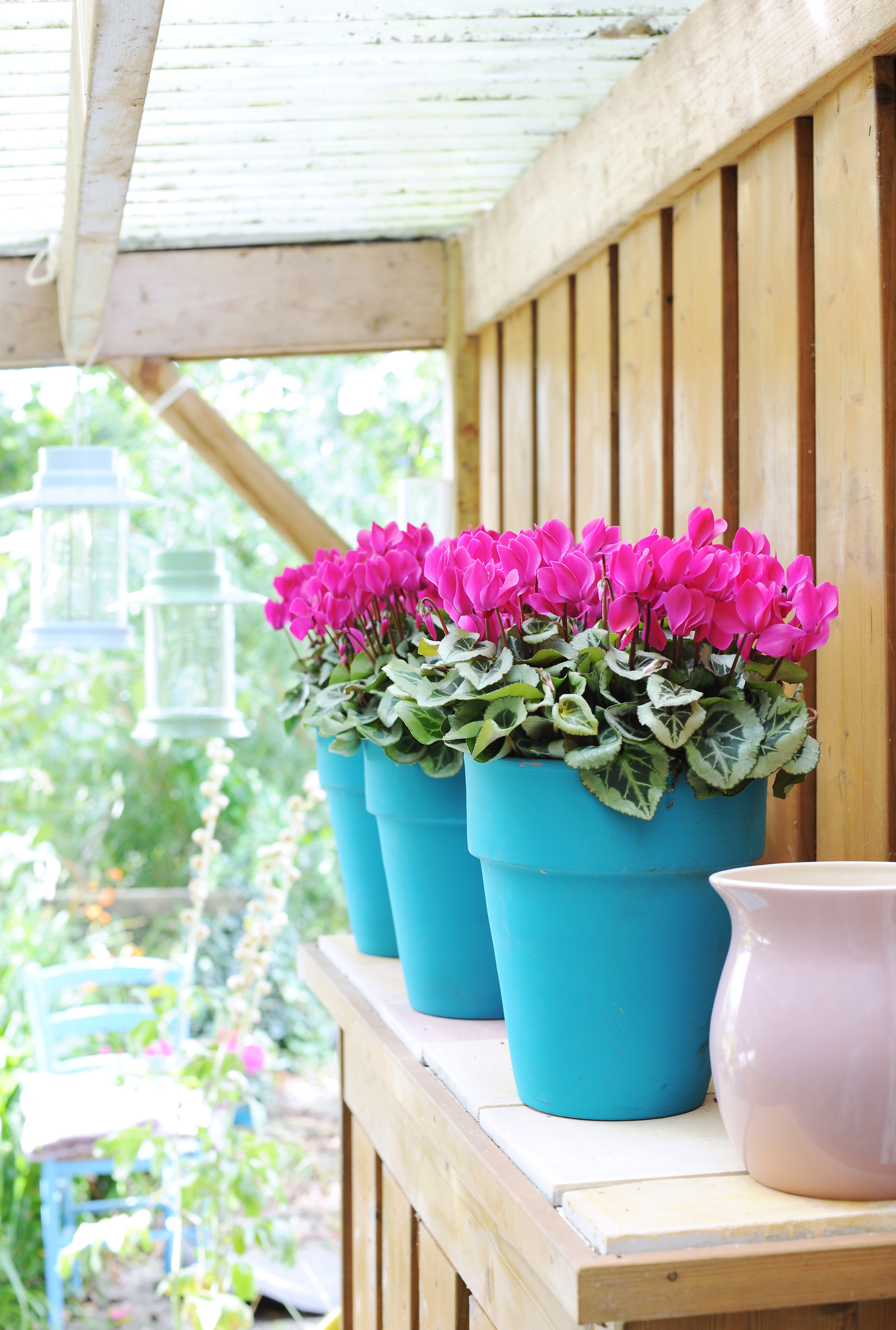
The flag-like flowers of cyclamen offer tons of beauty and are perfect plants for winter hanging baskets as well as pots.
The ones on sale in supermarkets tend to be tender, indoor cyclamen. So, make sure you choose a hardy variety called Cyclamen coum or Cyclamen hederifolium if you're after the best plants for winter pots. Plant them at the same depth as the pots you buy them in and avoid letting the containers become waterlogged, as this will damage the roots.
They can be bought as bulbs, but for a quick solution, ready-grown plants are inexpensive and create an instant uplift.
14. Snowdrops
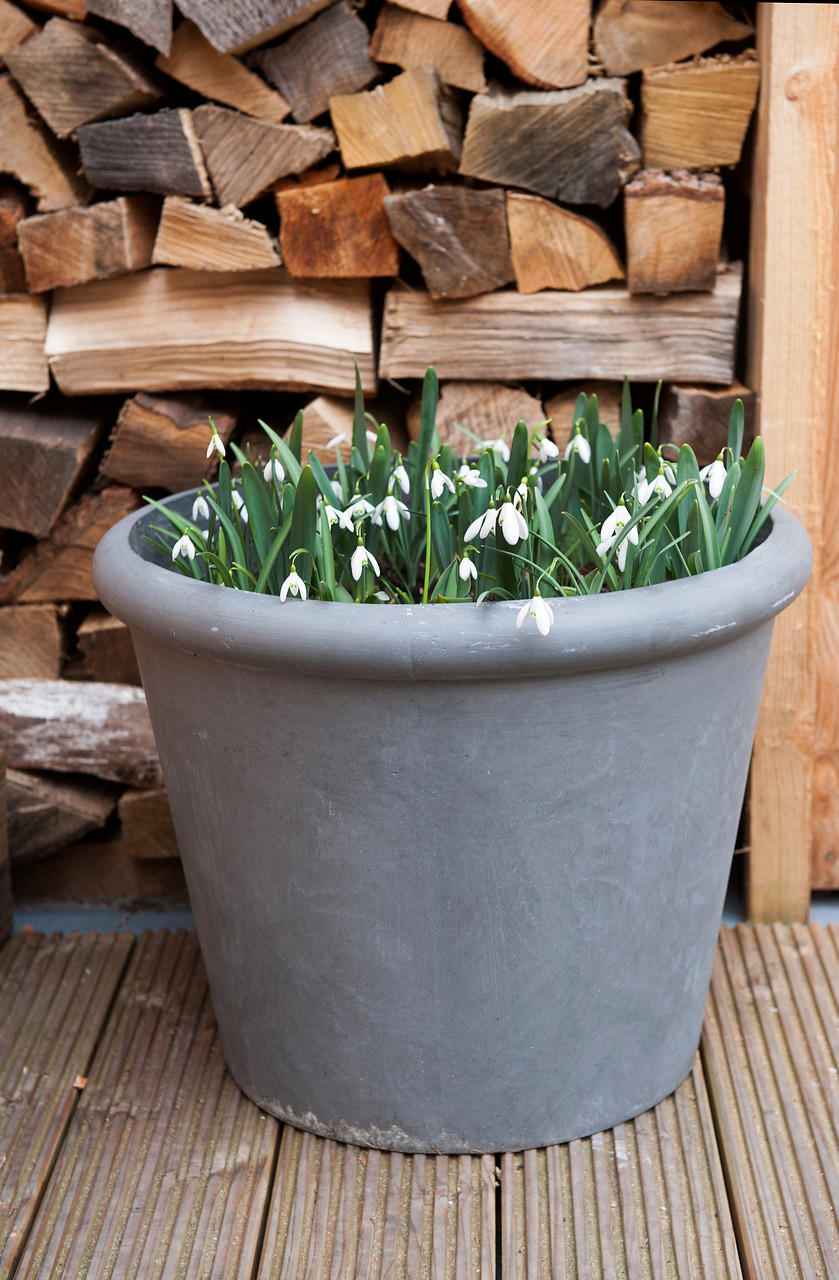
They're among the first spring bulbs to nose through the ground in winter, and a pot or two of snowdrops delivers a welcome boost.
Snowdrop bulbs can be planted in the autumn, or they may be grown 'in the green' (with their leaves still attached) in spring for flowering the following winter. They are happiest when growing in the ground in a shady garden border or raised bed – those grown in containers will need repotting every year.
Don't forget about the greater snowdrop too (Galanthus elwesii) – it has large, honey-scented white flowers above glaucous leaves.
15. Euonymus (Wintercreeper)
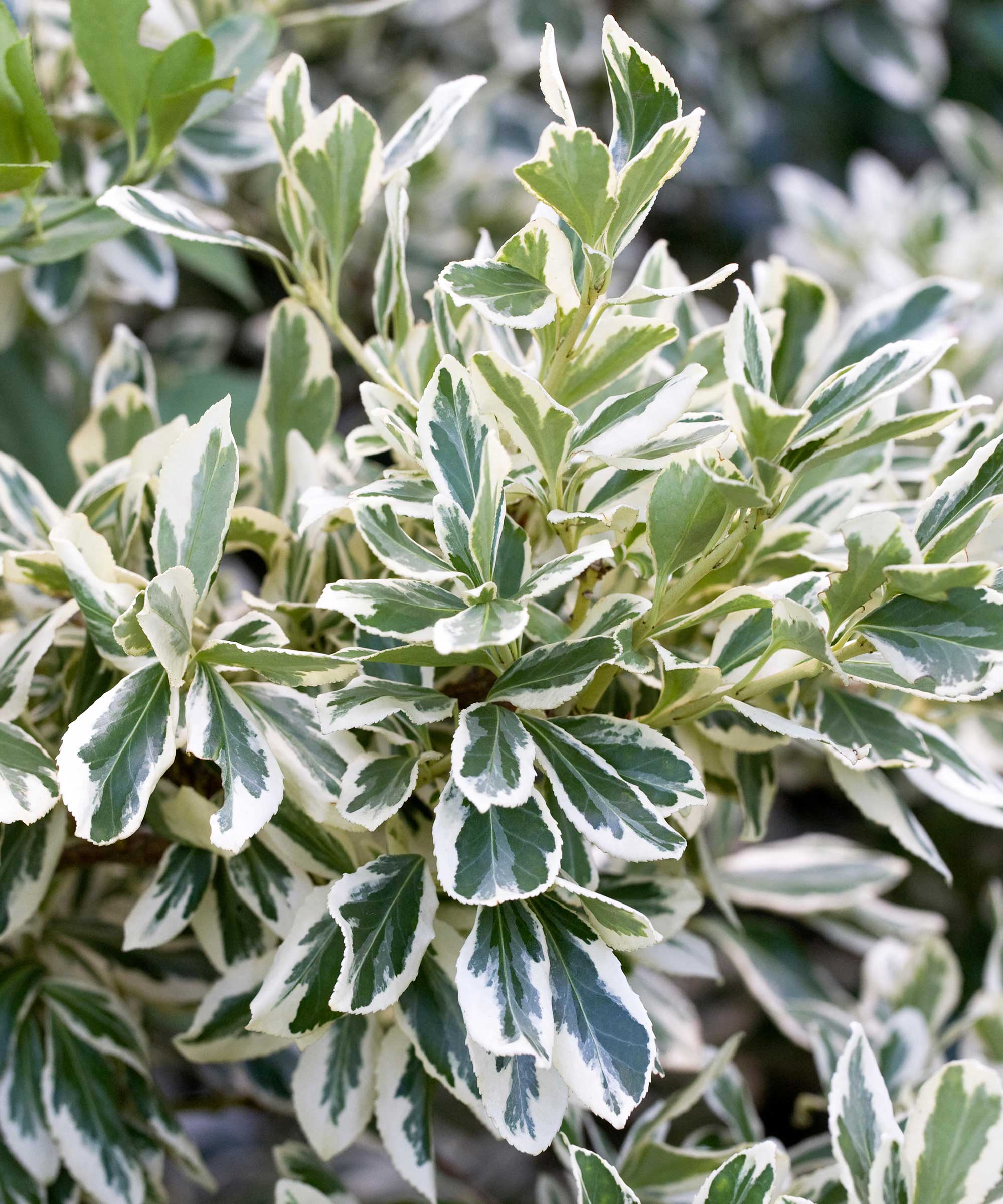
Some varieties of Euonymus fortunei are bushy, trailing or occasionally climbing evergreen shrubs and are well suited to larger containers. The best feature small, variegated leaves that turn pinkish in winter.
They are happy in sun or shade and in most soils, and pruning is rarely needed, says Graham Rice. 'Feed in spring.'
He recommends ‘Emerald ‘n’ Gold’ which has gold-edged leaves turning pink in winter. ‘Silver Queen’ is taller with white-edged leaves and makes a fine small specimen, he adds.
16. Vinca (Creeping Myrtle)
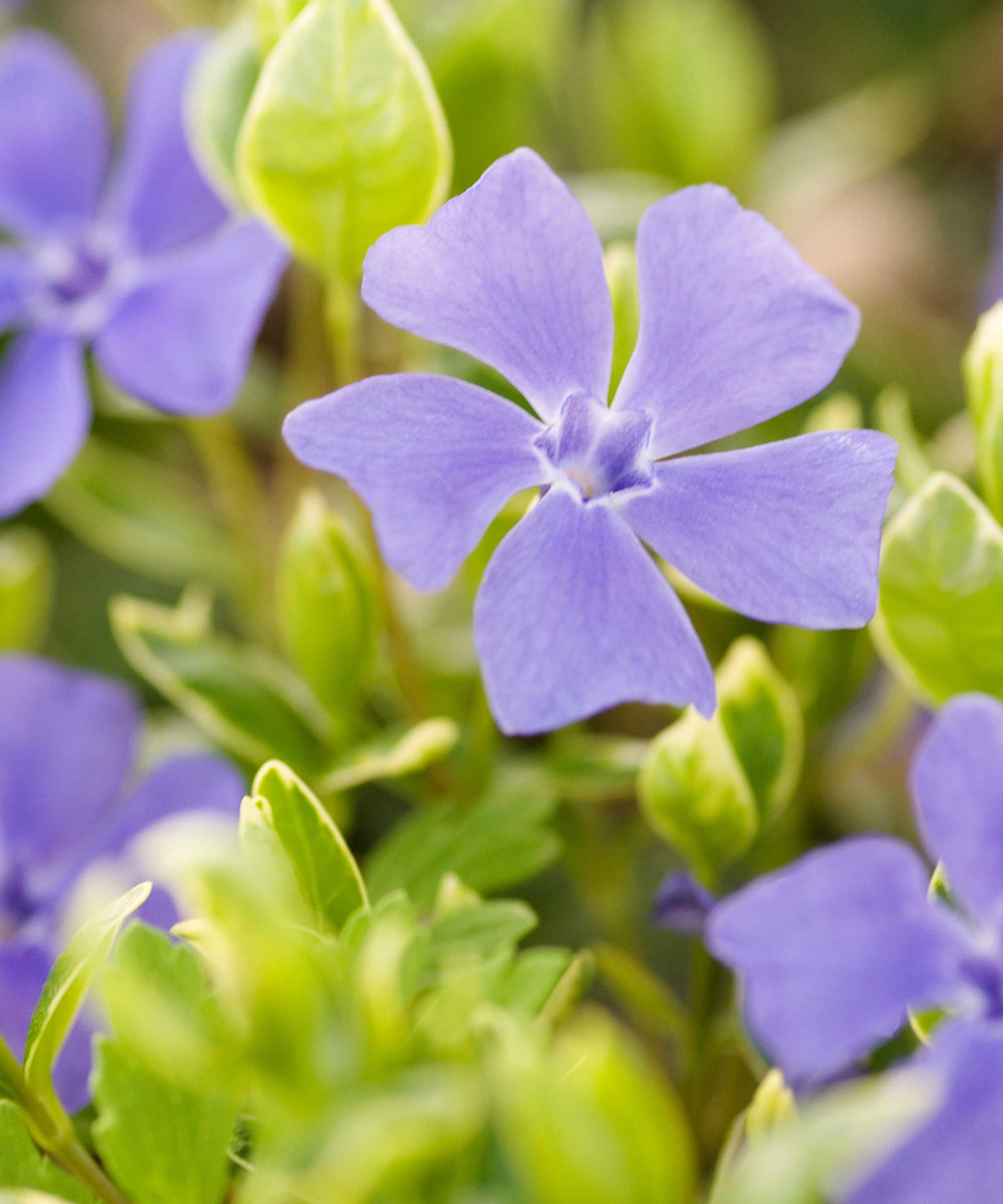
'Vinca minor is an exceptionally cold-hardy trailing or creeping evergreen, with neat dark foliage that is often brightly variegated,' says Graham. It has blue, purple or white flowers, a hardiness rating of USDA Z3 (RHS H6), and can grow to a height of 6-8in (15-20cm).
It's easy to please in any good container mix, but plant with caution as creeping myrtle is invasive in some areas. Tidy up with clean secateurs whenever necessary.
Graham recommends ‘Illumination’ (which has leaves splashed in gold with blue flowers), as well as ‘Ralph Shugert’ – shown above – which has silver-edged leaves and blue flowers.
17. Forced bulbs for indoors
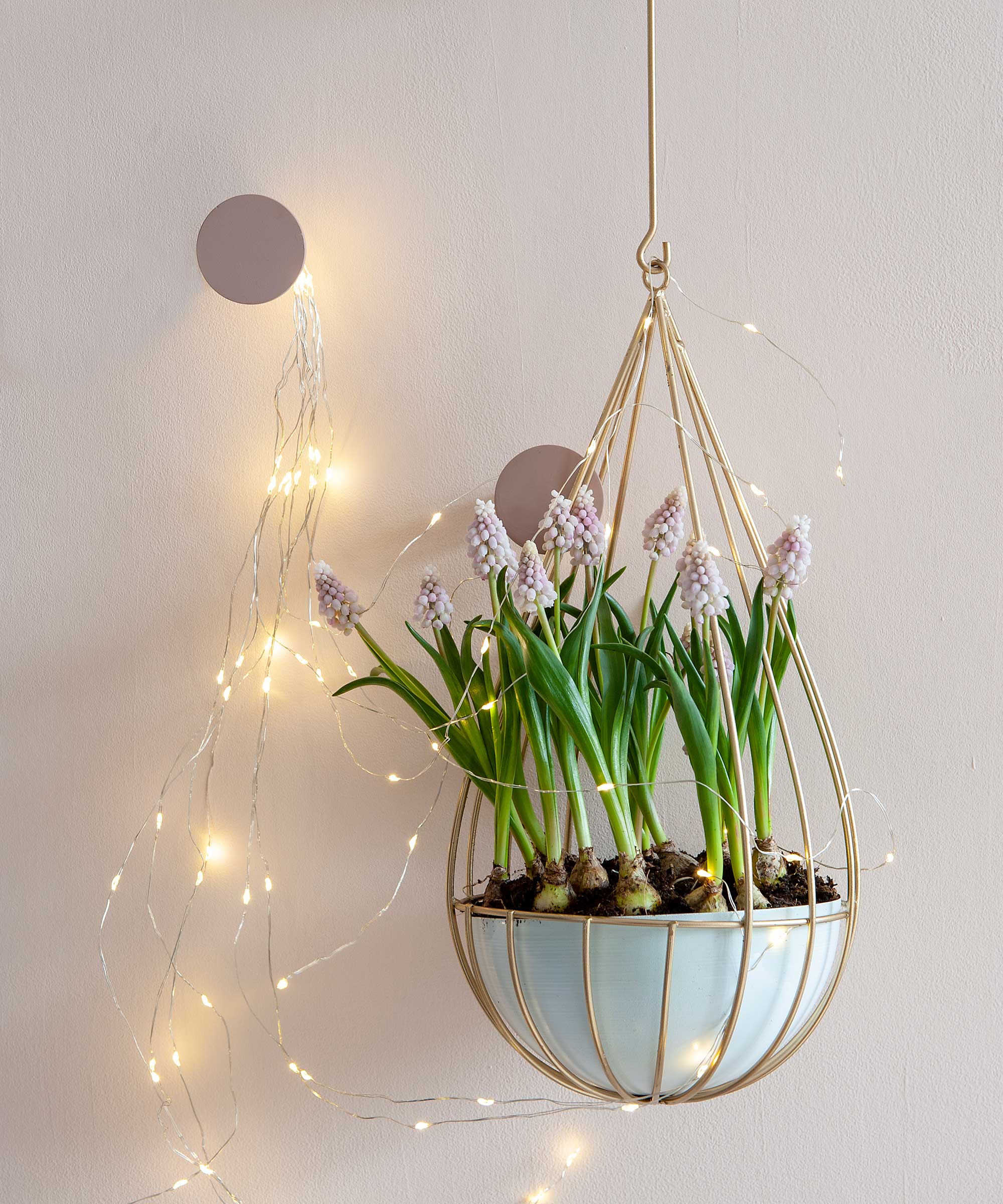
Winter containers aren't just for outdoors. Forcing bulbs is a lovely way to brighten up your interior and enjoy spring flowers early. There are all kinds you can try, from muscari (as seen above) to narcissus and sweetly-scented hyacinths.
Hang them up, decorate a window sill, or position them on the center of your dining table – they are bound to bring joy to any onlooker.
What are the best foliage plants for winter pots?
Winter containers don't have to feature flowers: as well as euonymus listed above, there is a fantastic choice of foliage plants available from garden centers or via mail order.
Opt for interestingly-shaped, frosted foliage plants such as calocephalus. You could also go for the downy leaves of dusty miller (Senecio cineraria) or try the frivolous, frilly leaves of ornamental kale such as 'Northern Lights', which intensifies in color as temperatures plummet.
A mix of foliage plants in similar tones looks stunning in the same pot. Soften the edges with an easy-to-grow evergreen trailing ivy such as 'White Wonder'.
- Buy ornamental kale in the US: view at Burpee
- Buy ornamental cabbage in the UK: view at Thompson & Morgan
Some hardy varieties of ornamental grasses can also fit beautifully into a winter container. For instance, try adding a few pots of tasteful blue fescue (Festuca glauca) for a year-round display of texture and a soft blue-green color. The spiky hummocks of foliage look particularly good in galvanized zinc containers. They need moist, well-drained soil, so add a handful of grit to the compost when planting.
- Buy Festuca glauca in the US: view at Nature Hills
- Buy Festuca glauca in the UK: view at Thompson & Morgan
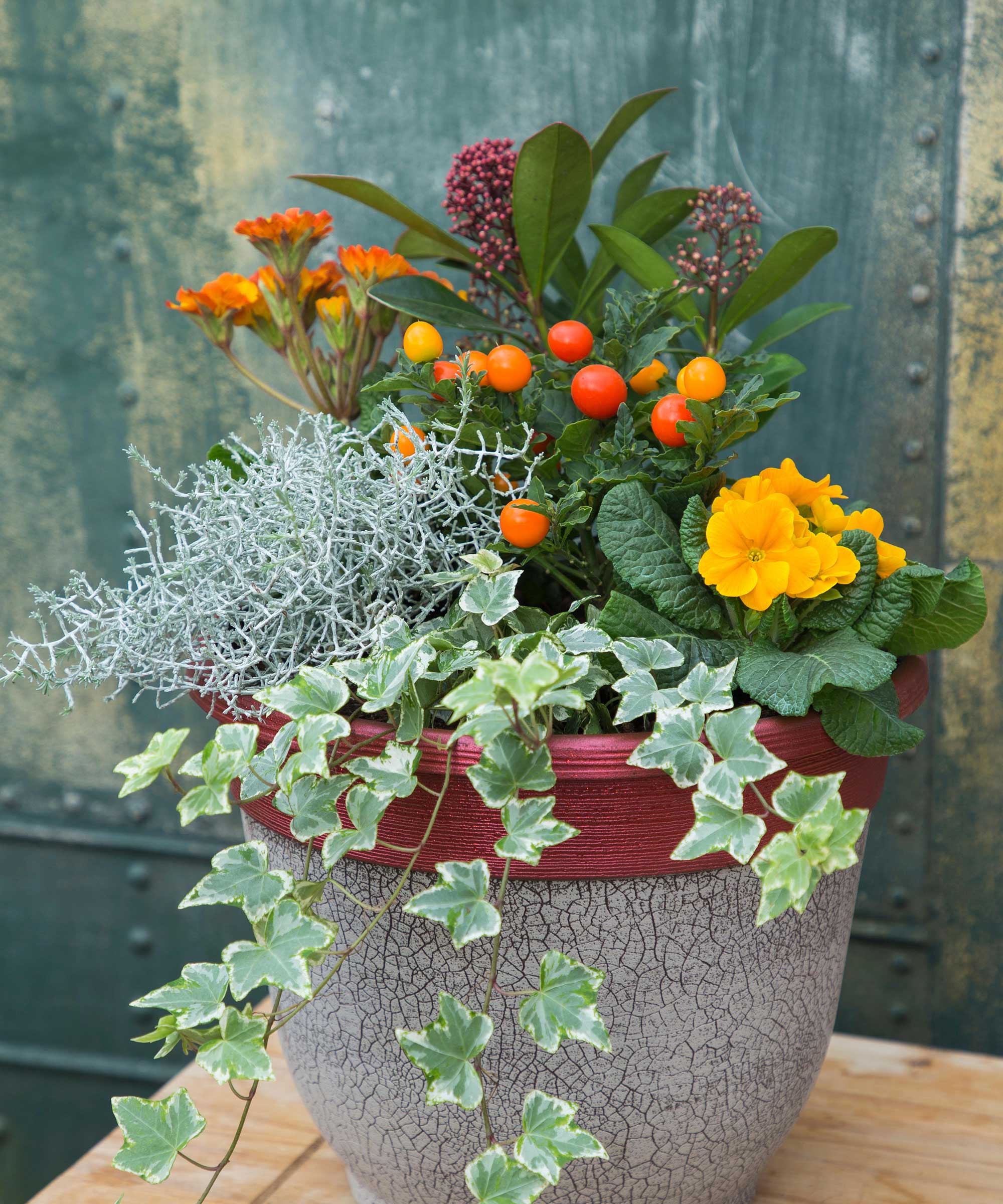
What plants are good for winter pots in shade?
Even a garden that doesn't get much sun can be brightened with a container, providing you choose shade-loving plants. Try these three winter varieties:
- Skimmia japonica 'Obsession': This evergreen shrub, growing to 31.5in (80cm), has red berries in fall and winter and scented spring blooms. It grows best in moist, well-drained pots of regular or ericaceous compost in sheltered shade or semi-shade.
- Mahonia x media ‘Charity’: An evergreen shrub, 13ft (4m) in height, this plant has architectural foliage and yellow flowers that exude a beautiful scent in winter. After flowering, plant it out in humus-rich soil in shade or semi-shade.
- Hedera helix ‘Buttercup’: This slow-growing trailing ivy has lime-green and lemon-yellow leaves when positioned in a shady spot, or bolder yellow leaves in sun. Avoid overcrowding, and plant in well-drained soil.
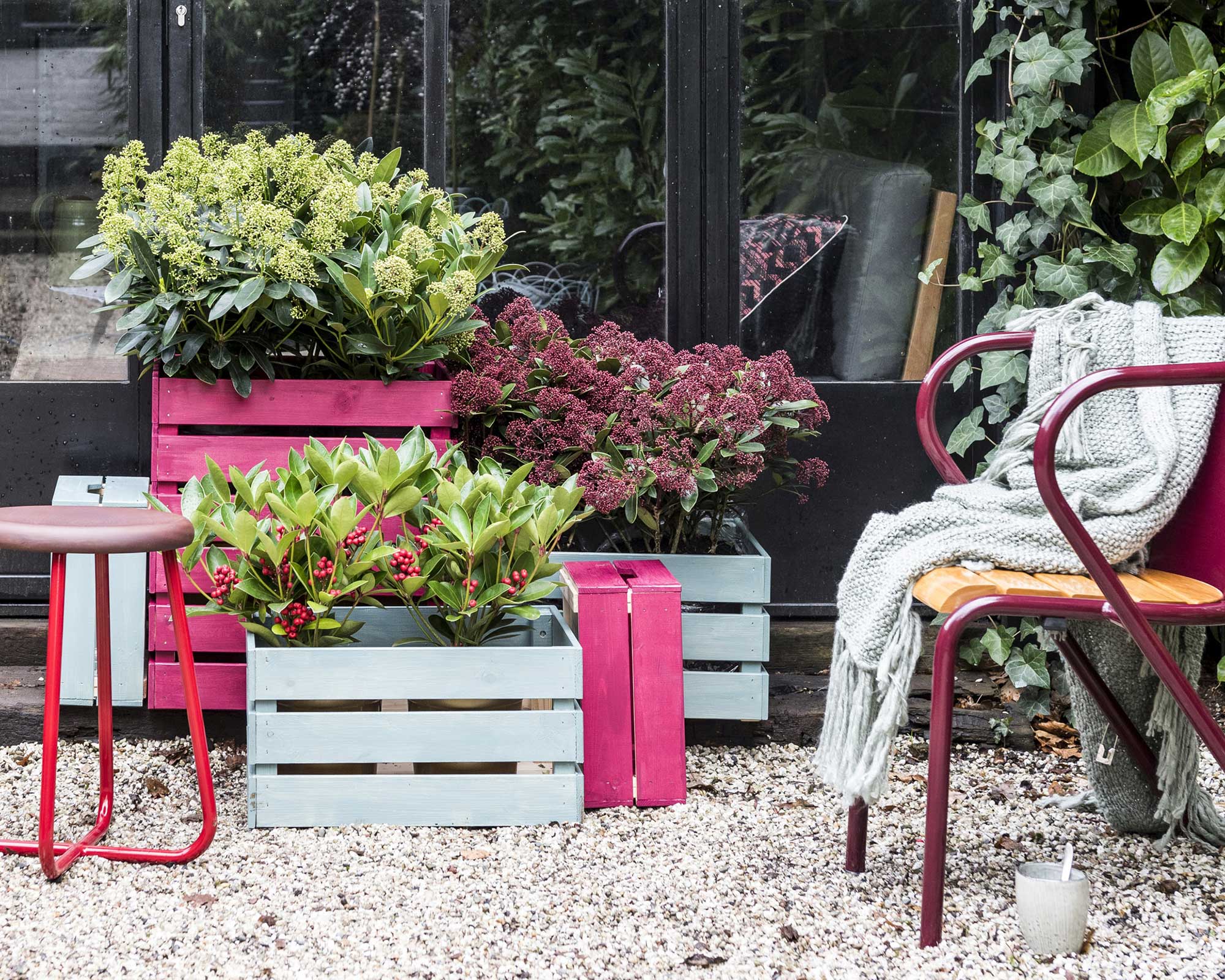
Where should you put a winter container in your garden?
'Think carefully about the siting of winter containers,' says Graham. 'You need to see them from the kitchen window or from the path where you pass every day, so place your containers to suit your garden layout and the most familiar sight lines.'
It's a good idea to provide a bit of protection against winter weather, too. 'Shelter from chilly winds and rain is a help, so tuck pots into the corner of a patio, against a wall or fence or by the door,' he says.
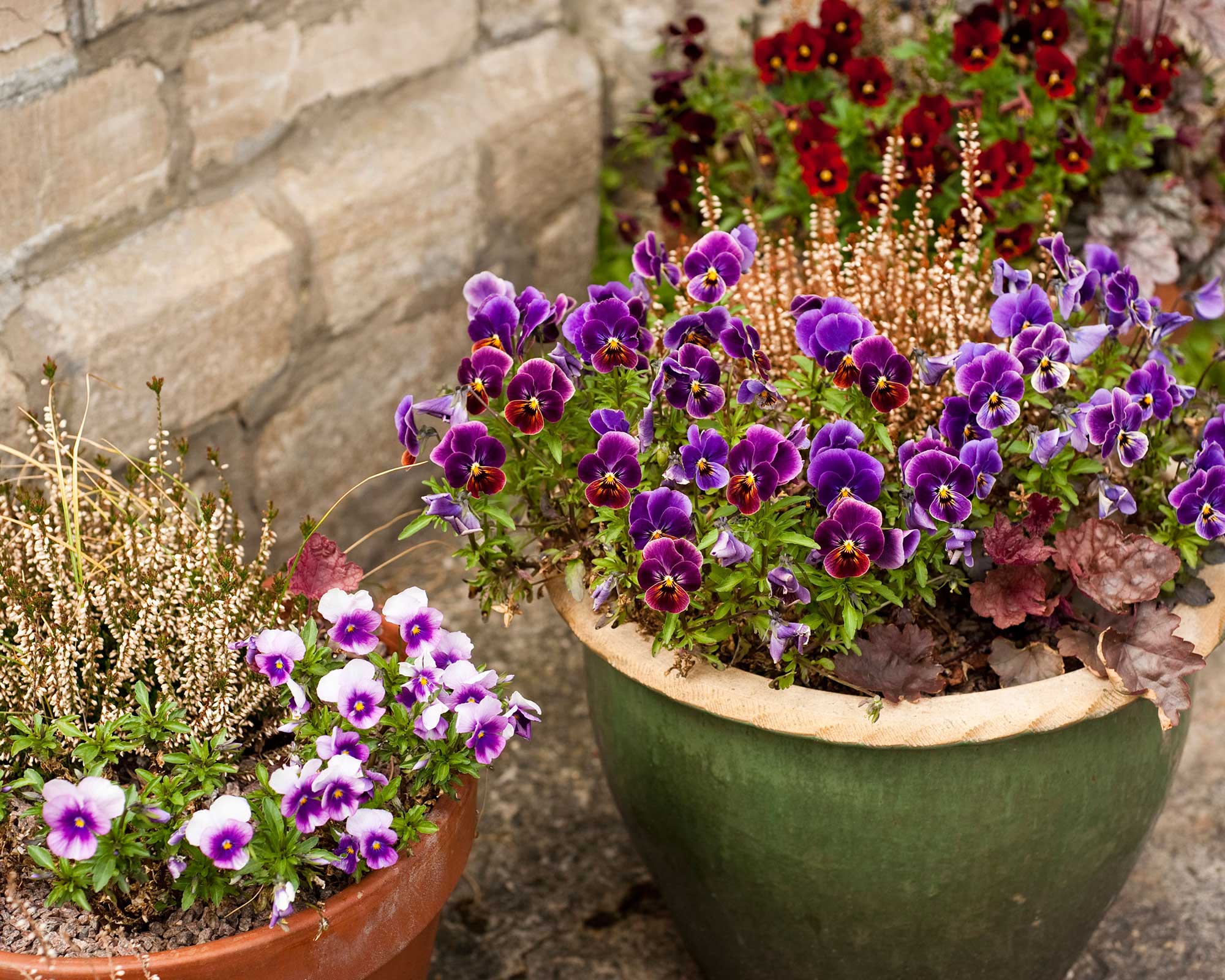
Should you water and fertilize winter containers?
True, summer is peak time for watering plants. But your containers may still need some attention with the watering can from time to time in winter, especially after sunny or windy weather or if they are under cover.
As Graham Rice advises, it does depend somewhat on where you live. In warmer climes, where many plants in containers will continue to grow through the winter, watering and occasional fertilizing will help them thrive. Just avoid doing so if frost is forecasted, says the RHS. It's important to ensure that your containers have good drainage. Allowing plants to sit in cold, waterlogged soil will do them no good at all.
'In colder areas, where growth ceases and the soil in containers may even freeze, both watering and feeding should cease until growth starts again in the spring,' Graham says.

An experienced freelance journalist, editor and columnist writing for national magazines and websites, Fiona now specialises in gardens. She enjoys finding and writing about all kinds, from the tiniest town plots to impressively designed ones in grand country houses.
- Holly CrossleyActing Deputy Editor
